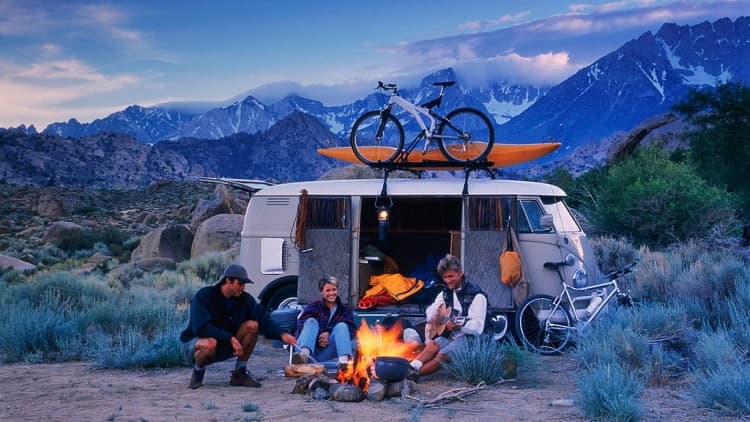Recreational vehicles (RVs), caravans, campervans or motorhomes - whatever size they are and whatever you call them, they are back and picking up a new generation of eager fans just wanting to hit the road.
Europe has seen a resurgence in leisure vehicle purchases, with consumers once again opting for these "big-ticket items" after the euro zone debt crisis of 2013 and the financial crash of 2008.
The latest numbers from the European Caravan Federation (ECF) show the European motorcaravan and caravan market did exceedingly well in 2016, registering its highest sales in seven years. A total of 170,064 leisure vehicles were newly registered in Europe in 2016, according to the ECF, a robust gain of 10.6 percent and a trend, it says, that reflects the continued popularity of caravan camping and travel in Europe as a whole.
In the first quarter of this year, Germany - the largest market for leisure vehicles - saw a 6 percent year-on-year rise with 14,366 new registrations, whereas Great Britain showed a 6.6 percent rise with 9,770 new vehicles registered. This comes as car sales in both countries remain weak, with Germany seeing just a 2 percent rise in the first half of 2017, and the U.K. seeing a contraction.
As well as buoyant consumer sentiment, many point to a rebranding and a change in attitude towards RVs, and also new vacation habits with people tending to take shorter trips. RVs or campers may have reached their zenith in the 1970s but fell out of favor in the 1980s and 1990s as more and more holiday-goers made the most of cheap flights and package deals. But that appears to be changing with a new younger fanbase that could potentially be spending cash in the sector for many years to come.
There is a "strong view" in the industry that certain sectors of the motorhome market - particularly van conversions - are now successfully appealing to a younger audience, according to John Lally, the director general of the NCC, a U.K. trade body for motorhome, caravan holiday home and park home industries.
"In a recent small-scale survey we undertook at dealerships, 20 percent confirmed that they were seeing younger buyers purchasing motorhomes. There are a couple of obvious reasons for this – first vehicles, particularly the smaller 'value' models that offer a lot of flexibility, are being designed with a younger demographic in mind," Lally said in a press statement on Wednesday, adding that new financing options also made vehicles more affordable for young couples. The organization also noted that new research at two consumer shows in the U.K. showed that attendees were indeed getting more youthful.
Volkswagen - synonymous with the VW camper - has spawned an entire sub-industry of companies that convert its commercial vans into habitable homes. However, the German automaker has itself launched several iterations of its new VW California campervan.

Complete with all the latest gadgets and driving aids a brand new vehicle can cost over £50,000 ($65,000). Mercedes also joined the market a few years ago with the Mercedes Marco Polo which can get even more expensive. A week-long rental might be a better option for those that don't want to buy, but that can still cost £900 ($1,170) for a top-of-the range California in peak season.
Kate Thompson, head of press and public relations at Volkswagen Commercial Vehicles, told CNBC via email that the California has really tapped into the "home is where you park it" vibe.
"In terms of millennials, this really appeals, with the addition of being able to share their experience via social media platforms, and potentially monetize their passion, in a way that wouldn't have been possible previously," she said.
"I receive regular correspondence from people (often under 35) who are giving up their jobs and taking themselves and their families off in a campervan to leave the rat race and find a new way of life. Beyond a vehicle it can enable a change of direction for people and offer new opportunities."

In the U.K., just under 900 new California models were sold as of the end of July, up 50 percent for last year and its Hannover factory in Germany saw a 37 percent rise in 2016 with 12,887 vehicles produced. An older demographic is still more likely to take the plunge and make a purchase but the more they're bought new, the more would presumably be available as secondhand vehicles for a wider audience.
In the U.S., shipments of RVs are expected to hit their highest level ever this year, according to the Recreation Vehicle Industry Association, marking the industry's eighth consecutive year of gains.
Those shipments should grow even more next year, and much of the growth can be attributed to strong sales of trailers, which are smaller units that can be towed behind an SUV (sports utility vehicle) or a minivan, the group said.
According to the 2017 North American Camping Survey from KOA, a private campground company, millennials make up 38 percent of campers, but 31 percent of the general population. Thus it seems that millennials are a major target market for RV companies.
-CNBC's David Gernon contributed to this report.


